
Thursday, October 16, 2014
Simple Complementary Push Pull Power Amplifier Circuit
Wednesday, October 15, 2014
Audio Power Amplifier for AM Radio Circuit Diagram
Tuesday, October 14, 2014
LM4765 create 2 x 30 watt amplifier
This 2 x 30 watt amplifier electronic circuit is very simple and require few external electronic parts and can be used in high end stereo TVs or some other audio applications .
Each amplifier has an independent smooth transition fadein/out mute and a power conserving standby mode which can be controlled by external logic.
Like many other audio amplifier ICs the LM4765 has many features like Temperature protection circuitry, SPiKe protection ( means that these parts are safeguarded at the output against overvoltage, undervoltage, overloads, including thermal runaway and instantaneous temperature peaks).
This audio amplifier electronic circuit project can be powered from a wide input voltage range from 20 volt up to 66 volts , but typically is required a dual 28 volts input ( take care because |Vcc|+|Vee|<60 volts .
The LM4765 has a sophisticated thermal protection scheme to prevent long-term thermal stress of the device. When the temperature on the die reaches 165°C, the LM4765 shuts down. It starts operating again when the die temperature drops to about 155°C, but if the temperature again begins to rise, shutdown will occur again at 165°C.
The audio IC must be mounted on a heat sink to keep the die temperature at a level such that the thermal protection circuitry does not operate under normal circumstances.
In this circuit diagram is represented just a part of the IC (one channel ) and numbers in parentheses represent pinout for amplifier B.

Monday, October 13, 2014
Signal Amplifier For TV explanation Charecteristics and circuit
It is connected between the antenna and the input of your receiver and boosts the signals by up to 20 dB, thus making it possible to receive even the weakest signals.
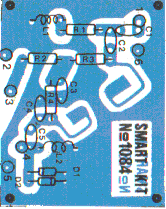 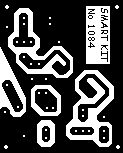 Dimensions (4,3cm x 5,4cm) |
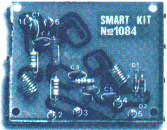
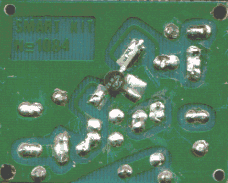
| Technical Specifications -Characteristics Frequency response: 40 - 900 MHz Gain: . 20 dB Maximum output level: 90 uV Input - output impedance: 75 ohm |
The circuit is built around a single transistor a UHF low signal device, the BFW 92. This transistor can operate in frequencies as high as 1.6 GHz, and has a gain of 23 dB. The signal from the antenna is applied to the input of the circuit and through C5 is fed to the base of the transistor. It is amplified and from the collector of the BFW 92 through C2 and C1 is taken to the input of the radio or TV receiver.
The circuit operates off a small 9 V battery which, because of the very low power consumption of the circuit, is going to last for a very long time.
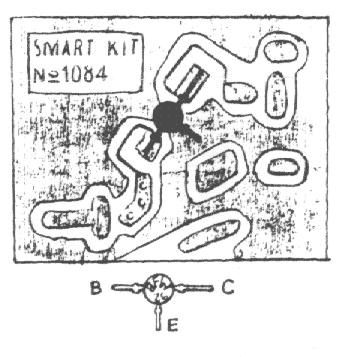
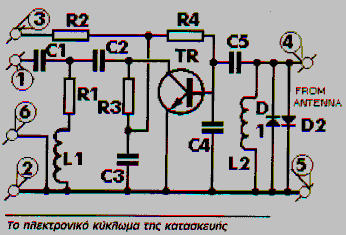
Construction
First of all let us consider a few basics in building electronic circuits on a printed circuit board. The board is made of a thin insulating material clad with a thin layer of conductive copper that is shaped in such a way as to form the necessary conductors between the various components of the circuit. The use of a properly designed printed circuit board is very desirable as it speeds construction up considerably and reduces the possibility of making errors. Smart Kit boards also come pre-drilled and with the outline of the components and their identification printed on the component side to make construction easier. To protect the board during storage from oxidation and assure it gets to you in perfect condition the copper is tinned during manufacturing and covered with a special varnish that protects it from getting oxidised and also makes soldering easier.
Soldering the components to the board is the only way to build your circuit and from the way you do it depends greatly your success or failure. This work is not very difficult and if you stick to a few rules you should have no problems. The soldering iron that you use must be light and its power should not exceed the 25 Watts. The tip should be fine and must be kept clean at all times. For this purpose come very handy specially made sponges that are kept wet and from time to time you can wipe the hot tip on them to remove all the residues that tend to accumulate on it. DO NOT file or sandpaper a dirty or worn out tip. If the tip cannot be cleaned, replace it. There are many different types of solder in the market and you should choose a good quality one that contains the necessary flux in its core, to assure a perfect joint every
time.
DO NOT use soldering flux apart from that which is already included in your solder. Too much flux can cause many problems and is one of the main causes of circuit malfunction. If nevertheless you have to use extra flux, as it is the case when you have to tin copper wires, clean it very thoroughly after you finish your work. In order to solder a component correctly you should do the following:
- Clean the component leads with a small piece of emery paper.
- Bend them at the correct distance from the component’s body and insert the component in its place on the board.
- You may find sometimes a component with heavier gauge leads than usual, that are too thick to enter in the holes of the p.c. board. In this case use a mini drill to enlarge the holes slightly. Do not make the holes too large as this is going to make soldering difficult afterwards.
- Take the hot iron and place its tip on the component lead while holding the end of the solder wire at the point where the lead emerges from the board. The iron tip must touch the lead slightly above the p.c. board.
- When the solder starts to melt and flow, wait till it covers evenly the area around the hole and the flux boils and gets out from underneath the solder. The whole operation should not take more than 5 seconds. Remove the iron and leave the solder to cool naturally without blowing on it or moving the component. If everything was done properly the surface of the joint must have a bright metallic finish and its edges should be smoothly ended on the component lead and the board track. If the solder looks dull, cracked, or has the shape of a blob then you have made a dry joint and you should remove the solder (with a pump, or a solder wick) and redo it.
- Take care not to overheat the tracks as it is very easy to lift them from the board and break them.
- When you are soldering a sensitive component it is good practice to hold the lead from the component side of the board with a pair
of long-nose pliers to divert any heat that could possibly damage the component.
- Make sure that you do not use more solder than it is necessary as you are running the risk of short-circuiting adjacent tracks on the board, especially if they are very close together.
- When you finish your work, cut off the excess of the component leads and clean the board thoroughly with a suitable solvent to
remove all flux residues that may still remain on it.
The project is a very easy one, as the components which form the circuit are very few and their outlines have been clearly stencilled on the board for you. The only unusual thing is that the transistor must be soldered from the copper side of the board. This is, however, common with UHF devices and is usually done to avoid the introduction of stray capacitances between the transistor’s leads that could possibly alter the behaviour of the circuit. Be careful to make good joints and try to keep the component leads as short as possible because of the very high frequencies involved. Solder first of all the pins and the resistors. The coils are supplied ready to be soldered on the printed circuit and you
should take care not to deform them in the process. Place then the capacitors and solder the diodes carefully trying to avoid overheating them and making sure that they are correctly aligned. Solder the transistor in its place, after you have finished soldering the other components, to avoid overheating it, and be careful to align it according to the diagram included in the instructions. (The lettering on the transistor body should be facing away from the copper). The input of the circuit is at point 4 and ground and the output at point 1 and ground. The battery is connected using the battery clip supplied at points 2 (-) and 3 (+), and is a miniature 9 V one, alkaline if you prefer. For best performance and to avoid unwanted interference during operation it is recommended to place the circuit in a small metal box, and use suitable connectors mounted on the box for the external connections. You can use a box large enough to house the amplifier and the battery or you can use an external power supply, but remember to use a FEED THROUGH capacitor on the positive supply line, where it passes through the metal box. If you plan to use the amplifier for both VHF and UHF TV reception you should use a common VHF/UHF mixer before the amplifier’s input.
R2 = 1,5 KOhm (brown, green, red)
R3 = 270 Ohm (red, violet, brown)
R4 = 82 KOhm (gray, red, orange)
C1,C5 = 100pF (ceramic)
C2,C3 = 1nF (ceramic)
C4 = 2,2pF (ceramic)
D1,D2 = 1N4148 diode
Transistor = BFR90, BFR91, BFW92
Misc = PCB, 6pins, solder, 9V battery clip
Friday, October 3, 2014
60 Watt Guitar Amplifier with Tone Control
Note:
To set quiescent current, tide ampare meter in series between supplay with this series, then do the following
- Set the volume control to the minimum and Trimmer R3 to its minimum resistance.
- Power-on the circuit and adjust R3 to read a current drawing of about 30 to 35mA.
- Wait about 15 minutes, watch if the current is varying and readjust if necessary.
List component
R1,R2______________68K 1/4W Resistors
R3________________680K 1/4W Resistor
R4________________220K 1/4W Resistor
R5_________________33K 1/4W Resistor
R6,R16______________2K2 1/4W Resistors
R7__________________5K6 1/4W Resistor
R8,R21____________330R 1/4W Resistors
R9_________________47K 1/4W Resistor
R10_______________470R 1/4W Resistor
R11_________________4K7 1/4W Resistor
R12,R20____________10K 1/4W Resistors
R13_______________100R 1/4W Resistor
R14,R15____________47R 1/4W Resistors
R17,R18,R19_______100K 1/4W Resistors
R22__________________6K8 1W Resistor
R23,R25_____________470R 1/4W Resistors
R24__________________2K 1/2W Trimmer Cermet
R26,R27_______________4K7 1/2W Resistors
R28________________220R 1/2W Resistor
R29__________________2K2 1/2W Resistor
R30_________________50K 1/2W Trimmer Cermet
R31________________68K 1/4W Resistor
R32,R33______________R47 4W Wirewound Resistors
C1,C4,C5,C6________10µF 63V Electrolytic Capacitors
C2_________________47µF 63V Electrolytic Capacitor
C3_________________47pF 63V Ceramic Capacitor
C7_________________15nF 63V Polyester Capacitor
C8_________________22nF 63V Polyester Capacitor
C9________________470nF 63V Polyester Capacitor
C10,C11,C12________10µF 63V Electrolytic Capacitors
C13_______________220µF 63V Electrolytic Capacitor
C14,C15,C17,C18________47µF 63V Electrolytic Capacitors
C16________________100µF 25V Electrolytic Capacitor
C19_________________33pF 63V Ceramic Capacitor
C20_______________1000µF 50V Electrolytic Capacitor
P1,P2______________10K Potentiometers
P3_________________10K Potentiometer
D1,D2____________BAT46 100V 150mA Schottky-barrier Diodes
D3_________________LED
Q1,Q3____________BC546 NPN Transistors
Q2_______________BC556 PNP Transistor
Q4,Q5____________BD139 80V 1.5A NPN Transistors
Q6_____________MJ11016 120V 30A NPN Darlington Transistor
Q7_____________MJ11015 120V 30A PNP Darlington Transistor
J1,J2___________6.3mm. Mono Jack sockets
SW1,SW2___________SPST Switches
SPKR______________speakers 8 or 4 Ohm with Minimum power 75W
Tuesday, September 23, 2014
Simple Class A Power Amplifier by IRF530
I was in need of high quality headphones amplifier because of many reasons and decided to build SDS Labs phone amp. This is extremely rewarding project in a sense that it is fully documented, includes PCB, parts list and building notes – so it’s easy to build and then it sounds great.
I have used IRF530 and IRF9530 pairs and they work just fine given the fact that you add 100-300 Ohm gate resistors to prevent high frequency oscillations. This is a common problem for MOSFET designs and if you don’t have a good oscilloscope or want to be on the safe side just use gate resistors on any MOSFET design. Ferrite beads put over gate pin could also be used instead but I somehow prefer resistors.
Monday, September 22, 2014
Class A Power Amplifier by IRF530N 78L05
This is the best design I have came up so far!
I use two 6x6x4cm heatsinks per channel. Power supply is unregulated (just transformer, diode bridge and capacitors) but I cannot hear anything even when I put my ear within few centimeters of the loudspeaker. Opamp has very good power supply rejection ratio. I’ve tried to keep everything as simple as possible and basically LM317 would be just one extra opamp
If you are looking for better sound, get separate regulated low power supply just for the U1 opamp, something like +-15V at 100-200 mA.
I have also used one LM7805 to get bias for both channels – you may want to use two separate 7805 in a final amp to get better channel separation. R2 pot is anything from 500 to 50k. I have used 22k.
Sunday, September 21, 2014
Generic Amplifier
 |
| Generic Amplifier |




